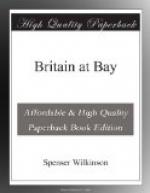Regular forces ........................ 123,250 Army reserve .......................... 134,110 Special reserves ...................... 67,780 Militia ............................... 9,158 Territorial force ..................... 209,977 Officers’ training corps .............. 416 ________
Total in the United Kingdom ...... 544,691
In Egypt and the Colonies:—
Regular forces ........................ 45,002
The British troops in India are paid for by the Indian Government and do not appear in the British Army Estimates. Of the force maintained in the United Kingdom, it will be observed that it falls, roughly, into three categories.
In the first place come the first-rate troops which may be presumed to have had a thorough training for war. This class embraces only the regulars and the army reserve, which together slightly exceed a quarter of a million. In the second class come the 68,000 of the special reserve, which, in so far as they have enjoyed the six months’ training laid down in the recent reorganisation, could on a sanguine estimate be classified as second-class troops, though in view of the fact that their officers are not professional and are for the most part very slightly trained, that classification would be exceedingly sanguine. Next comes the territorial force with a maximum annual training of a fortnight in camp, preceded by ten to twenty lessons and officered by men whose professional training, though it far exceeds that of the rank and file, falls yet very much short of that given to the professional officers of a first-rate continental army. The territorial force, by its constitution, is not available to fight England’s battles except in the United Kingdom, where they can never be fought except in the event of a defeat of the navy.
This heterogeneous tripartite army is exceedingly expensive, its cost during the current year being, according to the Estimates, very little less than 29 millions, the cost of the personnel being 23-1/2 millions, that of materiel being 4 millions, and that of administration 1/2 millions.
The British regular army cannot multiply soldiers as does the German army. It receives about 37,000 recruits a year. But it sends away to India and the Colonies about 23,000 each year and seldom receives them back before their eight years’ colour service are over, when they pass into the first-class reserve. There pass into the reserve about 24,000 men a year, and as the normal term of reserve service is four years, its normal strength is about 96,000 men.
As the regular army contains only professional soldiers, who look, at any rate for a period of eight years, to soldiering as a living, and are prepared for six or seven years abroad, there is a limit to the supply of recruits, who are usually under nineteen years of age, and to whom the pay of a shilling a day is an attraction. Older men with prospects of regular work expect wages much higher than that, and therefore do not enlist except when in difficulties.




